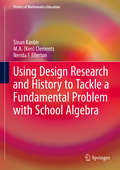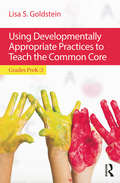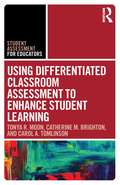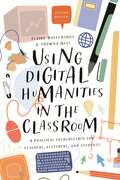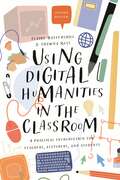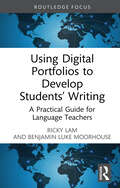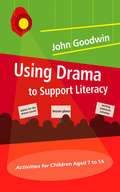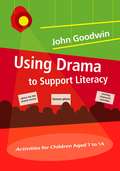- Table View
- List View
Using Debate in the Classroom: Encouraging Critical Thinking, Communication, and Collaboration
by Karyl A. Davis M. Leslie Wade Zorwick James Roland Melissa Maxcy WadeDebate holds enormous potential to build 21st century skills such as critical thinking, communication, collaboration, and conflict resolution in the K-12 classroom, but teachers often struggle to implement and contextualize it effectively. Using Debate in the Classroom draws on research from a variety of academic disciplines to explain the benefits of debate across subject areas, and describes how teachers can use debate to enliven their curriculum and support the aims of the Common Core. Topics include: Introducing debate as a pedagogical practice to engage students, improve school culture, and disrupt the school to prison pipeline. Using debate to teach critical literacy and improve students’ reading, writing, and speaking skills. Implementing role-playing techniques to strengthen information literacy and reasoning skills. Building students’ empathy, perspective-taking skills, and cultural humility as they confront difficult social issues through debate. Appendices provide a variety of tools to assist K-12 teachers in implementing debate in the classroom, including ready-made debate activities, student handouts, and a step-by-step guide to introducing students to debate in just one week.
Using Design Research and History to Tackle a Fundamental Problem with School Algebra (History of Mathematics Education)
by Sinan Kanbir M. A. Clements Nerida F. EllertonIn this well-illustrated book the authors, Sinan Kanbir, Ken Clements, and Nerida Ellerton, tackle a persistent, and universal, problem in school mathematics—why do so many middle-school and secondary-school students find it difficult to learn algebra well? What makes the book important are the unique features which comprise the design-research approach that the authors adopted in seeking a solution to the problem. The first unique feature is that the authors offer an overview of the history of school algebra. Despite the fact that algebra has been an important component of secondary-school mathematics for more than three centuries, there has never been a comprehensive historical analysis of factors influencing the teaching and learning of that component.The authors identify, through historical analysis, six purposes of school algebra: (a) algebra as a body of knowledge essential to higher mathematical and scientific studies, (b) algebra as generalized arithmetic, (c) algebra as a prerequisite for entry to higher studies, (d) algebra as offering a language and set of procedures for modeling real-life problems, (e) algebra as an aid to describing structural properties in elementary mathematics, and (f) algebra as a study of variables. They also raise the question whether school algebra represents a unidimensional trait.Kanbir, Clements and Ellerton offer an unusual hybrid theoretical framework for their intervention study (by which seventh-grade students significantly improved their elementary algebra knowledge and skills). Their theoretical frame combined Charles Sanders Peirce’s triadic signifier-interpretant-signified theory, which is in the realm of semiotics, with Johann Friedrich Herbart’s theory of apperception, and Ken Clements’ and Gina Del Campo’s theory relating to the need to expand modes of communications in mathematics classrooms so that students engage in receptive and expressive modes. Practicing classroom teachers formed part of the research team.This book appears in Springer’s series on the “History of Mathematics Education.” Not only does it include an important analysis of the history of school algebra, but it also adopts a theoretical frame which relies more on “theories from the past,” than on contemporary theories in the field of mathematics education. The results of the well-designed classroom intervention are sufficiently impressive that the study might havecreated and illuminated a pathway for future researchers to take.
Using Developmentally Appropriate Practices to Teach the Common Core: Grades PreK–3
by Lisa S. GoldsteinUsing Developmentally Appropriate Practices to Teach the Common Core: Grades PreK–3 provides current and prospective primary grade teachers with an understanding of the CCSS-ELA and CCSS-M that highlights their compatibility with developmentally appropriate practices (DAP), the instructional approach generally preferred by teachers of young children. The book begins by framing the CCSS as a distinct improvement over lengthy lists of academic content standards and as a carefully conceptualized and DAP-friendly set of curriculum guidelines. Next, the CCSS-ELA and CCSS-M for Grades K–3 are unpacked, analyzed, synthesized, and cross-referenced to key features of DAP. Finally, several "hot topic" issues—differentiating instruction to meet the needs of all learners, ensuring equitable access to the curriculum for English Language Learners, addressing assessment and accountability expectations, and educating parents and families about the CCSS and DAP—are prioritized and examined in depth. Using Developmentally Appropriate Practices to Teach the Common Core: Grades PreK–3 is a highly useful guide for both pre-service and in-service early childhood education teachers.
Using Developmentally Appropriate Practices to Teach the Common Core: Grades PreK–3
by Lisa S. GoldsteinUsing Developmentally Appropriate Practices to Teach the Common Core: Grades PreK–3 provides current and prospective primary grade teachers with an understanding of the CCSS-ELA and CCSS-M that highlights their compatibility with developmentally appropriate practices (DAP), the instructional approach generally preferred by teachers of young children. The book begins by framing the CCSS as a distinct improvement over lengthy lists of academic content standards and as a carefully conceptualized and DAP-friendly set of curriculum guidelines. Next, the CCSS-ELA and CCSS-M for Grades K–3 are unpacked, analyzed, synthesized, and cross-referenced to key features of DAP. Finally, several "hot topic" issues—differentiating instruction to meet the needs of all learners, ensuring equitable access to the curriculum for English Language Learners, addressing assessment and accountability expectations, and educating parents and families about the CCSS and DAP—are prioritized and examined in depth. Using Developmentally Appropriate Practices to Teach the Common Core: Grades PreK–3 is a highly useful guide for both pre-service and in-service early childhood education teachers.
Using Differentiated Classroom Assessment to Enhance Student Learning (Student Assessment for Educators)
by Tonya R. Moon Catherine M. Brighton Carol A. TomlinsonUsing Differentiated Classroom Assessment to Enhance Student Learning introduces pre- and in-service teachers to the foundations, data use, and best practices of the DCA framework. As differentiated instruction practices increasingly enable K-12 educators to individualize learning in their classrooms, it is important that this framework be extended to assessment as well. This concise yet comprehensive book explains the science and rationale behind DCA as well as principles and strategies for both formative and summative assessments. Replete with vignettes, sample outputs, and recommendations, this is a lively and much-needed guide to understanding, enacting, and analyzing grouped and individualized assessments.
Using Differentiated Classroom Assessment to Enhance Student Learning (Student Assessment for Educators)
by Tonya R. Moon Catherine M. Brighton Carol A. TomlinsonUsing Differentiated Classroom Assessment to Enhance Student Learning introduces pre- and in-service teachers to the foundations, data use, and best practices of the DCA framework. As differentiated instruction practices increasingly enable K-12 educators to individualize learning in their classrooms, it is important that this framework be extended to assessment as well. This concise yet comprehensive book explains the science and rationale behind DCA as well as principles and strategies for both formative and summative assessments. Replete with vignettes, sample outputs, and recommendations, this is a lively and much-needed guide to understanding, enacting, and analyzing grouped and individualized assessments.
Using Digital Humanities in the Classroom: A Practical Introduction for Teachers, Lecturers, and Students
by Claire Battershill Shawna RossRooted in the day-to-day experience of teaching and written for those without specialist technical knowledge, this is a new edition of the go-to guide to using digital tools and resources in the humanities classroom. In response to the rapidly changing nature of the field, this new edition has been updated throughout and now features:- A brand-new Preface accounting for new developments in the broader field of DH pedagogy- New chapters on 'Collaborating' and on 'Teaching in a Digital Classroom' - New sections on collaborating with other teachers; teaching students with learning differences; explaining the benefits of digital pedagogy to your students; and advising graduate students about the technologies they need to master- New 'advanced activities' and 'advanced assignment' sections (including bots, vlogging, crowd-sourcing, digital storytelling, web scraping, critical making, automatic text generation, and digital media art)- Expanded chapter bibliographies and over two dozen tables offering practical advice on choosing software programsAccompanied by a streamlined companion website, which has been entirely redesigned to answer commonly asked questions quickly and clearly, this is essential reading for anyone looking to incorporate digital tools and resources into their daily teaching.
Using Digital Humanities in the Classroom: A Practical Introduction for Teachers, Lecturers, and Students
by Claire Battershill Shawna RossRooted in the day-to-day experience of teaching and written for those without specialist technical knowledge, this is a new edition of the go-to guide to using digital tools and resources in the humanities classroom. In response to the rapidly changing nature of the field, this new edition has been updated throughout and now features:- A brand-new Preface accounting for new developments in the broader field of DH pedagogy- New chapters on 'Collaborating' and on 'Teaching in a Digital Classroom' - New sections on collaborating with other teachers; teaching students with learning differences; explaining the benefits of digital pedagogy to your students; and advising graduate students about the technologies they need to master- New 'advanced activities' and 'advanced assignment' sections (including bots, vlogging, crowd-sourcing, digital storytelling, web scraping, critical making, automatic text generation, and digital media art)- Expanded chapter bibliographies and over two dozen tables offering practical advice on choosing software programsAccompanied by a streamlined companion website, which has been entirely redesigned to answer commonly asked questions quickly and clearly, this is essential reading for anyone looking to incorporate digital tools and resources into their daily teaching.
Using Digital Portfolios to Develop Students’ Writing: A Practical Guide for Language Teachers (Routledge Research in Language Education)
by Ricky Lam Benjamin Luke MoorhouseThis book equips pre-service teachers, research postgraduate students, teacher educators, and language specialists with specific knowledge and skills about the principles, research, and applications of digital portfolios within the EFL writing contexts. While most digital portfolio scholarship focuses on higher education, this book targets primary-level and secondary-level school audiences, namely pre-service teachers, teacher educators, and Ministry of Education staff members with a focus on EFL writing. The rationale behind this design is that the published literature on digital portfolios tends to be generic and one-size-fits-all; there has been scant published scholarship about the development of digital portfolio literacy among teachers and pupils, which could enable them to upgrade the teaching and learning of writing in a larger EFL environment. This volume fills this gap by illustrating the why, what, and how aspects of digital portfolios in ten reader-friendly chapters. Guiding educators to enrich their pedagogical repertoire via the portfolio approach, this book emphasises a healthy balance between principles, research, and practice. It is an easy-to-follow guide to setting up digital portfolio systems and coaching pupils to improve writing, ensuring the dissemination of digital portfolios with high fidelity.
Using Digital Portfolios to Develop Students’ Writing: A Practical Guide for Language Teachers (Routledge Research in Language Education)
by Ricky Lam Benjamin Luke MoorhouseThis book equips pre-service teachers, research postgraduate students, teacher educators, and language specialists with specific knowledge and skills about the principles, research, and applications of digital portfolios within the EFL writing contexts. While most digital portfolio scholarship focuses on higher education, this book targets primary-level and secondary-level school audiences, namely pre-service teachers, teacher educators, and Ministry of Education staff members with a focus on EFL writing. The rationale behind this design is that the published literature on digital portfolios tends to be generic and one-size-fits-all; there has been scant published scholarship about the development of digital portfolio literacy among teachers and pupils, which could enable them to upgrade the teaching and learning of writing in a larger EFL environment. This volume fills this gap by illustrating the why, what, and how aspects of digital portfolios in ten reader-friendly chapters. Guiding educators to enrich their pedagogical repertoire via the portfolio approach, this book emphasises a healthy balance between principles, research, and practice. It is an easy-to-follow guide to setting up digital portfolio systems and coaching pupils to improve writing, ensuring the dissemination of digital portfolios with high fidelity.
Using Discourse Analysis to Improve Classroom Interaction
by Lesley A. Rex Laura SchillerThis accessible 'how to' text is about classroom interaction – how to study it and how to use that knowledge to improve teaching and learning. Actually showing what critical, constructionist, sociocultural perspectives on teaching, learning, and schooling are and what they can do, it makes discourse analysis understandable and useful to teachers and other nonlinguists. Using Discourse Analysis to Improve Classroom Interaction: offers teachers the powerful tools of discourse analysis as a way of understanding the complex dynamics of human interaction that constitute effective, equitable teaching and learning guides readers step-by-step through how to build their interactional awareness to improve their teaching includes 'Try It Out' exercises to engage readers in learning how to respond to the social dynamics of their classrooms for the purpose of improving classroom interaction. Proceeding from simple illustrations to more complex layering of analytical concepts, short segments of talk, transcribed to highlight important points, are used to explain and illustrate the concepts. By the time readers get to the complicated issues addressed in this text they are ready to deal with some of teaching’s toughest challenges, and have the tools to build positive relationships among their students so that all can participate equally in the classroom.
Using Discourse Analysis to Improve Classroom Interaction
by Lesley A. Rex Laura SchillerThis accessible 'how to' text is about classroom interaction – how to study it and how to use that knowledge to improve teaching and learning. Actually showing what critical, constructionist, sociocultural perspectives on teaching, learning, and schooling are and what they can do, it makes discourse analysis understandable and useful to teachers and other nonlinguists. Using Discourse Analysis to Improve Classroom Interaction: offers teachers the powerful tools of discourse analysis as a way of understanding the complex dynamics of human interaction that constitute effective, equitable teaching and learning guides readers step-by-step through how to build their interactional awareness to improve their teaching includes 'Try It Out' exercises to engage readers in learning how to respond to the social dynamics of their classrooms for the purpose of improving classroom interaction. Proceeding from simple illustrations to more complex layering of analytical concepts, short segments of talk, transcribed to highlight important points, are used to explain and illustrate the concepts. By the time readers get to the complicated issues addressed in this text they are ready to deal with some of teaching’s toughest challenges, and have the tools to build positive relationships among their students so that all can participate equally in the classroom.
Using Drama to Support Literacy: Activities for Children Aged 7 to 14
by John Goodwin'This book will be a welcome, practical addition to the repertoires of teachers of children aged 7-11 who are looking for inspiration and relevance in their teaching of writing skills' - Speaking English `For the drama novice, this is the book to buy. It reveals drama's power, maps the route to success, and empowers the reader to follow' - Literacy Time `All activities are inspiring and imaginative, and the written activities that follow them are varied and interesting...this book will prove useful, especially in the upper primary and middle school' - English Drama Media Using ideas and activities already tried and tested in the classroom, this book shows practitioners how imaginative drama lessons and activities can be used to help encourage and improve children's writing, speaking and listening skills. Perfect for the person who might not be used to leading drama-based activities, this book takes a step-by step approach that will help even the most daunted teacher tackle drama with confidence. Also included are: - ideas for suitable writing and drama activities - advice on lesson planning - list of useful resources - examples of children's work and teachers' comments Class teachers, teaching assistants, literacy consultants and drama and English co-ordinators looking for practical, fun drama activities to support literacy will find all the help they need in this book.
Using Drama to Support Literacy: Activities for Children Aged 7 to 14 (PDF)
by John Goodwin'This book will be a welcome, practical addition to the repertoires of teachers of children aged 7-11 who are looking for inspiration and relevance in their teaching of writing skills' - Speaking English `For the drama novice, this is the book to buy. It reveals drama's power, maps the route to success, and empowers the reader to follow' - Literacy Time `All activities are inspiring and imaginative, and the written activities that follow them are varied and interesting...this book will prove useful, especially in the upper primary and middle school' - English Drama Media Using ideas and activities already tried and tested in the classroom, this book shows practitioners how imaginative drama lessons and activities can be used to help encourage and improve children's writing, speaking and listening skills. Perfect for the person who might not be used to leading drama-based activities, this book takes a step-by step approach that will help even the most daunted teacher tackle drama with confidence. Also included are: - ideas for suitable writing and drama activities - advice on lesson planning - list of useful resources - examples of children's work and teachers' comments Class teachers, teaching assistants, literacy consultants and drama and English co-ordinators looking for practical, fun drama activities to support literacy will find all the help they need in this book.
Using Drama to Teach Personal, Social and Emotional Skills (PDF)
by Angie Wootten Jacqui O'HanlonIncludes CD-Rom Originally developed for deaf children, this innovative and successful drama programme addressing personal, social and emotional needs can benefit all children in primary schools. The interactive and lively ideas cover a variety of themes from empathy to assertiveness. Each of the 6 modules in the book provides 3-5 session plans which include games, drama exercises and discussion that build up the children's exploration of each theme. Copiable resources are included, and a 'How to Use' section has practical suggestions on how the material may be used and adapted for different children and varying situations. An evaluation sheet is also provided which can be used to track the progress of individual children. A final appendix contains a compendium of games which can be interchanged to suit the needs of the children. Bringing together the expertise of a drama teacher and the skills of a teacher of the deaf, the book is a very practical resource providing everything a busy teacher needs to engage all young people as participants in a PSHE curriculum. Angie Wootten has been a teacher of deaf children for over twenty years. She is also a regional tutor and a placement supervisor for the course leading to the qualification as a teacher of the deaf at Birmingham University. In 1999, as a research fellow with the same university, she researched and co-wrote the RNID publication A Review of Good Practice in Deaf Education. In 2002 she completed an MPhil relating to oral communication and deaf adults. Angie has worked with deaf children of all ages, from babies to college students. She is currently working as an outreach teacher in Warwickshire. Jacqui is an actress and Deputy Director of Education for the Royal Shakespeare Company.
Using Drama with Children on the Autism Spectrum: A Resource for Practitioners in Education and Health
by Carmel ConnThe second edition of Using Drama with Children on the Autism Spectrum takes the perspective that support for the learning and development of children should have the purpose of giving them the freedom to be more fully who they are and able to function more effectively as themselves in a wider range of contexts. The focus of this new edition is on learning outcomes as expressed by autistic people, for example, to develop better understandings about the social world and to know how to manage everyday situations more successfully. This practical resource book contains more than 150 activities for use with children aged 5–11 years old. Written for mainstream and special education teachers, speech and language therapists, drama teachers, play workers and creative arts therapists, the book shows how using drama with children across the autism spectrum can provide valuable experiences in being with others and communicating with them in enjoyable ways that support the development of well-being and confidence. In addition, drama is presented as a rich medium for reflecting on everyday social situations and developing children’s understandings about the social world. Complete with case studies, photocopiable resources and step-by-step guidance on how to facilitate drama activities that all children can enjoy, this practical resource will be invaluable for those who are looking for new ways of engaging children on the autism spectrum and their peers. The second edition of this practical resource has been extensively revised, updated and re-focused in line with current practice and thinking.
Using Drama with Children on the Autism Spectrum: A Resource for Practitioners in Education and Health
by Carmel ConnThe second edition of Using Drama with Children on the Autism Spectrum takes the perspective that support for the learning and development of children should have the purpose of giving them the freedom to be more fully who they are and able to function more effectively as themselves in a wider range of contexts. The focus of this new edition is on learning outcomes as expressed by autistic people, for example, to develop better understandings about the social world and to know how to manage everyday situations more successfully. This practical resource book contains more than 150 activities for use with children aged 5–11 years old. Written for mainstream and special education teachers, speech and language therapists, drama teachers, play workers and creative arts therapists, the book shows how using drama with children across the autism spectrum can provide valuable experiences in being with others and communicating with them in enjoyable ways that support the development of well-being and confidence. In addition, drama is presented as a rich medium for reflecting on everyday social situations and developing children’s understandings about the social world. Complete with case studies, photocopiable resources and step-by-step guidance on how to facilitate drama activities that all children can enjoy, this practical resource will be invaluable for those who are looking for new ways of engaging children on the autism spectrum and their peers. The second edition of this practical resource has been extensively revised, updated and re-focused in line with current practice and thinking.
Using Educational Criticism and Connoisseurship for Qualitative Research
by P Bruce Uhrmacher Christy McConnell Moroye David J. FlindersUsing Educational Criticism and Connoisseurship for Qualitative Research develops the practical elements of educational criticism, a form of qualitative inquiry that takes its lead from the work that critics have done in fields such as the visual arts, music, literature, drama and dance. Written by leading scholars in the field of curriculum studies, and research methods, this book explores the interpretive and evaluative aspects of educational criticism, through which the educational critic offers means for understanding and attributing significance to educational events. Featuring chapter-by-chapter activities, guiding questions, and key terms, this volume addresses matters of study design, pedagogy, and trends in doing educational criticism and connoisseurship. By offering a uniquely in-depth account of this research method, Using Educational Criticism and Connoisseurship for Qualitative Research is accessible to researchers and students in curriculum and instruction, educational leadership, and higher education.
Using Educational Criticism and Connoisseurship for Qualitative Research
by P Bruce Uhrmacher Christy McConnell Moroye David J. FlindersUsing Educational Criticism and Connoisseurship for Qualitative Research develops the practical elements of educational criticism, a form of qualitative inquiry that takes its lead from the work that critics have done in fields such as the visual arts, music, literature, drama and dance. Written by leading scholars in the field of curriculum studies, and research methods, this book explores the interpretive and evaluative aspects of educational criticism, through which the educational critic offers means for understanding and attributing significance to educational events. Featuring chapter-by-chapter activities, guiding questions, and key terms, this volume addresses matters of study design, pedagogy, and trends in doing educational criticism and connoisseurship. By offering a uniquely in-depth account of this research method, Using Educational Criticism and Connoisseurship for Qualitative Research is accessible to researchers and students in curriculum and instruction, educational leadership, and higher education.
Using Educational Research to Inform Practice: A Practical Guide to Practitioner Research in Universities and Colleges
by Lorraine Foreman-Peck Christopher WinchThis book gives practical guidance on how educational research can inform professional practice. Written in a clear and accessible style, it details the way in which evidence based knowledge can be used to develop teaching and learning, bringing together a range of resources for all levels of reader but specifically designed to aid the progressive practitioner researcher. The authors draw on their experience of empirical work in education to provide thoroughly up-to-date reference material, including illustrative case studies, practical guidelines and exercises, and definitions of educational and research terms. The case studies and critical literature surveys have been chosen to demonstrate the use (and mis-use) of research evidence in thinking about a range of important topics in further and higher education, such as, learning styles, deep and surface learning, dyslexia in higher education, the assessment of group work, teaching critical thinking, problem based learning, and dissertation marking. Drawing on their philosophical backgrounds, the authors also address the much conceptual confusions which have led to scepticism regarding the wisdom or even the possibility of using research evidence to inform teaching. Other guidance includes: relating practitioner knowledge to educational research ethical and practical issues on research within the institution evaluating the strengths and limitations of research evidence researching ideas through the examination of case studies practitioner research and contributions to the knowledge base Using Educational Research to Inform Practice provides the necessary understanding for conducting research, thinking about its value and applying research evidence to practice in universities and colleges and therefore will be essential reading for those resource managers who are responsible for providing courses and support in higher education institutions. In addition, this book is particularly aimed at further and higher lecturers undertaking professional development courses and experienced and senior staff who wish to use research to improve management practices.
Using Educational Research to Inform Practice: A Practical Guide to Practitioner Research in Universities and Colleges
by Lorraine Foreman-Peck Christopher WinchThis book gives practical guidance on how educational research can inform professional practice. Written in a clear and accessible style, it details the way in which evidence based knowledge can be used to develop teaching and learning, bringing together a range of resources for all levels of reader but specifically designed to aid the progressive practitioner researcher. The authors draw on their experience of empirical work in education to provide thoroughly up-to-date reference material, including illustrative case studies, practical guidelines and exercises, and definitions of educational and research terms. The case studies and critical literature surveys have been chosen to demonstrate the use (and mis-use) of research evidence in thinking about a range of important topics in further and higher education, such as, learning styles, deep and surface learning, dyslexia in higher education, the assessment of group work, teaching critical thinking, problem based learning, and dissertation marking. Drawing on their philosophical backgrounds, the authors also address the much conceptual confusions which have led to scepticism regarding the wisdom or even the possibility of using research evidence to inform teaching. Other guidance includes: relating practitioner knowledge to educational research ethical and practical issues on research within the institution evaluating the strengths and limitations of research evidence researching ideas through the examination of case studies practitioner research and contributions to the knowledge base Using Educational Research to Inform Practice provides the necessary understanding for conducting research, thinking about its value and applying research evidence to practice in universities and colleges and therefore will be essential reading for those resource managers who are responsible for providing courses and support in higher education institutions. In addition, this book is particularly aimed at further and higher lecturers undertaking professional development courses and experienced and senior staff who wish to use research to improve management practices.
Using Effectiveness Data for School Improvement: Developing and Utilising Metrics
by Anthony Kelly Christopher DowneyData metrics in schools are becoming increasingly complex, but despite their best efforts, teachers and academics generally find them something of a ‘black-box’. This book lifts the lid on that box, exploring the provenance and problematization of existing techniques and developing new algorithms for measuring the more oblique aspects of in-school performance. Using contextual value-added measures in England as a foundation - they have become the template of choice for policy-makers around the world and a basis for some excellent school effectiveness research - the book explores the potential of performance and progress data to guide student and teacher self-evaluation, to set targets and allocate resources, to evaluate initiatives and identify good practice, to assess and reward staff responsibility, and to inform policy in relation to emerging issues like school choice, equality of opportunity and post-compulsory progression. Chapters are sectioned in three parts - ‘Past’, ‘Present’ and ‘Future’ - and cover: the historical journey from raw-threshold to refined-contextual measures of school effectiveness research and policy on pupil attainment and value-added data the leading UK government and Fischer Family Trust models issues relating to differential effectiveness and the interpretation of data how best to blend data from different sources new non-cognitive metrics for assessing social and emotional aspects of learning (SEAL) and staff responsibility managing data for school improvement and understanding professional attitudes to it. Using Effectiveness Data for School Improvement brings together for the first time in one place the various metrics and models, and their basis in research. A full technical specification is included so that both ‘data experts’ and ‘data novices’, academics and practitioners, can use the book to understand and maximize what is potentially a hugely transforming, but under-utilized, resource and an increasingly important aspect to school and curriculum management.
Using Effectiveness Data for School Improvement: Developing and Utilising Metrics
by Anthony Kelly Christopher DowneyData metrics in schools are becoming increasingly complex, but despite their best efforts, teachers and academics generally find them something of a ‘black-box’. This book lifts the lid on that box, exploring the provenance and problematization of existing techniques and developing new algorithms for measuring the more oblique aspects of in-school performance. Using contextual value-added measures in England as a foundation - they have become the template of choice for policy-makers around the world and a basis for some excellent school effectiveness research - the book explores the potential of performance and progress data to guide student and teacher self-evaluation, to set targets and allocate resources, to evaluate initiatives and identify good practice, to assess and reward staff responsibility, and to inform policy in relation to emerging issues like school choice, equality of opportunity and post-compulsory progression. Chapters are sectioned in three parts - ‘Past’, ‘Present’ and ‘Future’ - and cover: the historical journey from raw-threshold to refined-contextual measures of school effectiveness research and policy on pupil attainment and value-added data the leading UK government and Fischer Family Trust models issues relating to differential effectiveness and the interpretation of data how best to blend data from different sources new non-cognitive metrics for assessing social and emotional aspects of learning (SEAL) and staff responsibility managing data for school improvement and understanding professional attitudes to it. Using Effectiveness Data for School Improvement brings together for the first time in one place the various metrics and models, and their basis in research. A full technical specification is included so that both ‘data experts’ and ‘data novices’, academics and practitioners, can use the book to understand and maximize what is potentially a hugely transforming, but under-utilized, resource and an increasingly important aspect to school and curriculum management.
Using Emerging Technologies to Develop Professional Learning
by Jean Murray and Warren KiddInternationally, there is a growing body of research about learners’ responses to, and uses of, emerging technologies. However, the adoption of these technologies in teachers’ professional development is still largely under-researched. Much of the existing literature still positions teachers as playing ‘catch-up’ in terms of using technology for teaching and learning in an ever expanding and changing world, and ignores the roles that these emerging technologies can play in teacher, and teacher educator, development and learning.This book aims to address the lack of research in the area, and it contributes to the new knowledge area of how emerging technologies can effectively address professional learning, drawing on case studies and perspectives from across the world. Contributors use a wide variety of approaches to analyse the potential for emerging (and established) technologies, including digital, Web2.0, social media, and IT tools, to develop ‘effective’ or ‘deep’ professional learning for pre- and in-service teachers and teacher educators. This book was originally published as a special issue of Professional Development in Education.
Using Emerging Technologies to Develop Professional Learning
by Jean Murray Warren KiddInternationally, there is a growing body of research about learners’ responses to, and uses of, emerging technologies. However, the adoption of these technologies in teachers’ professional development is still largely under-researched. Much of the existing literature still positions teachers as playing ‘catch-up’ in terms of using technology for teaching and learning in an ever expanding and changing world, and ignores the roles that these emerging technologies can play in teacher, and teacher educator, development and learning.This book aims to address the lack of research in the area, and it contributes to the new knowledge area of how emerging technologies can effectively address professional learning, drawing on case studies and perspectives from across the world. Contributors use a wide variety of approaches to analyse the potential for emerging (and established) technologies, including digital, Web2.0, social media, and IT tools, to develop ‘effective’ or ‘deep’ professional learning for pre- and in-service teachers and teacher educators. This book was originally published as a special issue of Professional Development in Education.

